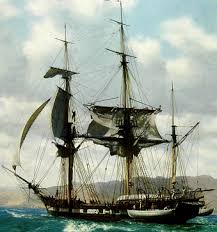December 27 is one of those days — many of us are off work, but it’s after Boxing Day, and it’s not yet on to New Year’s Eve or Day. We should have celebrated, maybe.
It’s the end of the year, and yet it is also a day of great beginnings.
We should celebrate December 27 as a day of portent: A good embarkation, and a good, safe end to a nation-encouraging trip to almost touch the Moon.
On December 27, 1831, Charles Darwin and H.M.S. Beagle set sail on an around-the-world voyage of discovery that would change all of science, and especially biology, forever.
December 27 1831
After a few delays, H.M.S. Beagle headed out from Plymouth with a crew of 73 under clear skies and a good wind. Darwin became sea-sick almost immediately.
Darwin never fully overcame his seasickness, but he fought it well enough to become the single greatest collector of specimens in history for the British Museum and British science, a distinction that won him election to science societies even before his return from the trip — and cemented his life in science, instead of in the church.
Darwin’s discoveries would have revolutionized biology in any case. But, in analyzing what he had found, a few years later and with the aid of experts at the British Museum, Darwin realized he had disproved much of William Paley’s hypotheses about life and its diversity, and that another, more basic explanation was possible. This led to his discovery of evolution by natural and sexual selection.
On December 27, 1968, Apollo 8 splashed down after a successful and heartening trip to orbit the Moon. The three crewmen, Commander Frank Borman, James A. Lovell, Jr., and William A. Anders, had orbited the Moon, a very important milestone in the methodological race to put humans on the Moon (which would be accomplished seven months later).
1968 was a terrible year for the U.S., with the North Korean capture of the U.S.S. Pueblo, assassinations of Rev. Martin Luther King, Jr., and Sen. Robert F. Kennedy during the presidential campaign, riots in dozens of American cities, nasty political conventions with riots at the Democratic Convention in Chicago, a contentious and bitter election making sore the nation’s divide over Vietnam policy, and other problems. On Christmas Eve, Borman, Lovell and Anders broadcast from orbit around the Moon, a triumphant and touching moment for the Apollo Program and Americans around the world. Their safe return on December 27 raised hopes for a better year in 1969.
Motherboard.tv has a great write up from Alex Pasternack, especially concerning the famous photo taken a few days prior to splashdown:
In 1968, NASA engineers were scrambling to meet President Kennedy’s challenge to land a man on the moon by decade’s end. Because delays with the lunar module were threatening to slow the Apollo program, NASA chose to change mission plans and send the crew of Apollo 8 all the way to the moon without a lunar module.
Exactly
43[49] years ago, the three astronauts of Apollo 8 became the first humans to orbit another celestial object. As they came around the dark side of the Moon for the third time, Frank Borman, the commander, finally turned their capsule around. And then they saw the Earth.Borman: Oh my God! Look at that picture over there! Here’s the Earth coming up. Wow, is that pretty.
Anders: Hey, don’t take that, it’s not scheduled.
Borman: (laughing) You got a color film, Jim?
Anders: Hand me that roll of color quick, will you…One of the resulting photos taken by Anders on a Hasselblad camera became one of the world’s most iconic images.
As Bill Anders recalls it:
I just happened to have one with color film in it and a long lens. All I did was to keep snapping… It’s not a very good photo as photos go, but it’s a special one. It was the first statement of our planet Earth and it was particularly impressive because it’s contrasted against this startling horizon . . . After all the training and studying we’d done as pilots and engineers to get to the moon safely and get back, [and] as human beings to explore moon orbit, what we really discovered was the planet Earth.
Plan to raise a glass today, December 27, 2012, to Great Beginnings Day for the human race. December 27 is a day we should remember, for these achievements. (But if you’re raising a glass, consider Carrie Nation, too!)
Also on December 27:
- 1900 – Carrie Nation brought her campaign against liquor and saloons to Wichita, Kansas, smashing the bar at the Carey Hotel
- 1927 – “Show Boat” with music by Jerome Kern and libretto by Oscar Hammerstein II, opened at the Ziegfeld Theater in New York City (AP)
- 1932 – Radio City Music Hall opened for the first time, with a stage that, to me, looks like an old radio (Library of Congress)
- 1945 – The World Bank was formed under the Bretton Woods Agreement of 1944, a key part of world finance structure following World War II
- 1949 – Indonesia gained independence in a grant from Queen Juliana of the Netherlands; Netherlands had ruled Indonesia for three centuries
- Birthdays: Johannes Kepler (1571), Louis Pasteur (1822), Cokie Roberts
More:
- 44 Years Ago Today: Apollo 8′s Historic Broadcast from the Moon on Christmas Eve in 1968 (launiusr.wordpress.com)
- With a view from beyond the moon, an astronaut talks religion, politics and possibilities (seattletimes.com)
- Apollo 40 years on: how the moon missions changed the world for ever (guardian.co.uk)
- Apollo 8 commander reflects on historic Christmas Eve moon mission, photo (billingsgazette.com)
- Apollo 8′s ‘Earthrise” 45 Years Later (outsidethebeltway.com)
- Smithsonian Tumblr on Darwin’s voyage beginning

Yes, this is an encore post. Defeating ignorance takes patience and perseverance.






 Posted by Ed Darrell
Posted by Ed Darrell 




















